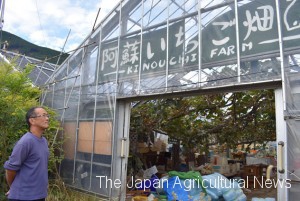
Murakami sadly looking at his strawberry house with which he so far has been giving up his business. (in Minamiaso village, Kumamoto Prefecture)
KUMAMOTO, Oct. 18 – In the Tateno district in the village of Minamiaso, Kumamoto Prefecture, farmers are still having difficulties resuming their business even 1.5 years after the destructive earthquakes in April 2016. Reconstruction efforts have been successfully made to recover water supply and rebuild new roads gradually, but most of the farmers in the region are still not able to resume their business back in their farmlands.
Lack of construction vendors
The Tateno district was severely hit by the earthquakes on April 16, 2016, with its most evident damage on the large Aso Ohashi bridge. Currently, the rice fields and other farmlands close to the collapsed bridge are filled with sand and gravel used for rebuilding the bridge.
“The infrastructure is gradually recovering, but most of us are still unable to make income from farming. It probably requires a lot more time for us to restart our business here,” said Susumu Murakami, president of Kinouchi Farm which used to make rice and strawberries on its 8-hectare farm in the region. Then he sighed deeply.
Murakami has lost 70% of his farmland because it collapsed and he had to provide it for the construction works. He now grows a minimal quantity of strawberries in summer on a trial basis. The earthquakes caused him an instant loss of hundreds of millions of yens, and the men with no income source now lives on his savings.
Water supply and roads are recovering gradually, but farming infrastructure recovery remains slow. Cuts in the water supply that continued for a long time after the earthquakes resumed partially after August this year when the Ministry of Land, Infrastructure, Transport, and Tourism (MLIT) and private companies build new water wells. The region now has a supply of 300 liters of water per minute, but this is “only a temporal measure,” according to Murakami. It’s not enough to rewater the entire region and the locals still have no idea when they can expect to have full water supply back.
Also in August, a new road to the central part of the village was opened close to Murakami’s farm. Murakami can expect a substantial amount of traffic on the road, and it could be an advantage for the farm designed to attract tourists. Actually, he has a plan to build a new 80-are greenhouse.
However, a lack of constructors in the region continues or is even getting severer due to the disasters in the neighborhood such as torrential rains in Kyushu in July. “I must build the greenhouse by the end of this year to apply for the governmental subsidies, but I don’t think I can make it,” Murakami said.
Evacuation directive to be lifted but farmers may not restart business
The farm industry in the region is far from restorations. No rice has been planted in the local rice fields for two years since the earthquakes.
On October 31, the village is going to ask the Prefectural government to lift the designation on 357 households in Tateno for their long-time evacuations, because the water and road restorations completed even though they are temporal. “This will make it possible for those evacuated to come back,” according to an official in charge of the village restoration efforts. However, Murakami said, “we have to wait for some more years until we see the full recovery of the water supply system. I’m not sure if old farmers can come home and restart their business at their farmlands, which have been left uncared for such a long time.”

